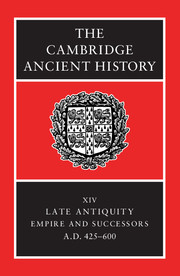Book contents
- Frontmatter
- PART I CHRONOLOGICAL OVERVIEW
- PART II GOVERNMENT AND INSTITUTIONS
- PART III EAST AND WEST: ECONOMY AND SOCIETY
- PART IV THE PROVINCES AND THE NON-ROMAN WORLD
- PART V RELIGION AND CULTURE
- 24 The organization of the church
- 25 Monasticism
- 26 Holy Men
- 27 The definition and enforcement of orthodoxy
- 28 Philosophy and philosophical schools
- 29 Education in the Roman empire
- 30 The visual arts
- 31 Building and architecture
- Conclusion
- Chronological Table
- BIBLIOGRAPHY
- Index
- References
28 - Philosophy and philosophical schools
from PART V - RELIGION AND CULTURE
Published online by Cambridge University Press: 28 March 2008
- Frontmatter
- PART I CHRONOLOGICAL OVERVIEW
- PART II GOVERNMENT AND INSTITUTIONS
- PART III EAST AND WEST: ECONOMY AND SOCIETY
- PART IV THE PROVINCES AND THE NON-ROMAN WORLD
- PART V RELIGION AND CULTURE
- 24 The organization of the church
- 25 Monasticism
- 26 Holy Men
- 27 The definition and enforcement of orthodoxy
- 28 Philosophy and philosophical schools
- 29 Education in the Roman empire
- 30 The visual arts
- 31 Building and architecture
- Conclusion
- Chronological Table
- BIBLIOGRAPHY
- Index
- References
Summary
INTRODUCTION
The dominant pagan philosophy of the fifth and sixth century a.d. was Neoplatonism. By this period Platonism had absorbed the other philosophical traditions of antiquity. Aristotle was extensively studied but in a Platonist context, and usually as a preparation for the study of Plato himself. Epicureanism and Scepticism had faded away. Many elements of Stoicism do reappear in Neoplatonist logic and metaphysics but altered and transposed so as to fit into a very different philosophical system: the Stoics were materialists, whereas for the Neoplatonists the intelligible world is not only distinct from the material one but superior to it in reality and power. Neoplatonism was initiated by Plotinus in the third century and continued into the fourth by Porphyry, Iamblichus and their followers; by 425 it had spread all over the Mediterranean world. There were several different schools, in the physical sense, and this chapter will consider those in order. I shall begin with the school of Athens, proceed to Alexandria and then conclude with a brief account of philosophy elsewhere in the empire. The two principal schools were in Athens and Alexandria. These schools have often been seen as differing in doctrines and attitudes as well as in their geographical location. However, recent research has undermined this conventional picture. I shall argue later in the chapter that there were some genuine differences in emphasis and attitude between the two schools. However, they both derived from the Iamblichean tradition of Neoplatonism, and I shall begin by summarizing the main features of that tradition.
- Type
- Chapter
- Information
- The Cambridge Ancient History , pp. 835 - 854Publisher: Cambridge University PressPrint publication year: 2001

